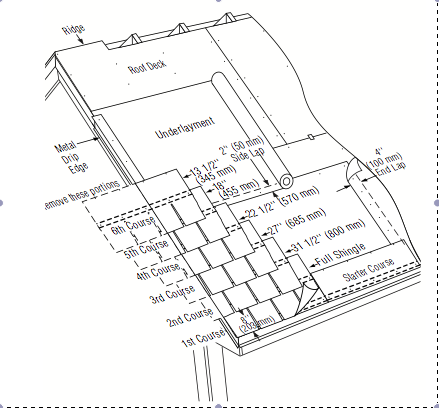Mastering Roof Inspections: Asphalt Composition Shingles, Part 24
by Kenton Shepard and Nick Gromicko, CMI®
The purpose of the series “Mastering Roof Inspections” is to teach home inspectors, as well as insurance and roofing professionals, how to recognize proper and improper conditions while inspecting steep-slope, residential roofs. This series covers roof framing, roofing materials, the attic, and the conditions that affect the roofing materials and components, including wind and hail.
RACKING
Installing shingles vertically up the roof instead of using the traditional stair-step method is called “racking.”

Courtesy of CertainTeed®
This diagram shows a conventional offset installation. The amount of offset varies with the model of shingle.

This diagram shows shingles installed using the racking method.

Racking is easy to recognize, once you know what to look for. On a racked roof, you’ll see joints staggered straight up the roof.

Joints should align at every other course.

The joints shown in this photo are in the center.
Racking is widely perceived as always being an improper installation. This is often true, but not always. Some manufacturers list racking as an acceptable method of installation for certain types of their shingles, but they also mention that it’s not the preferred method.
At least one major manufacturer requires that certain types of their shingles be installed using the racking method.
If you see racking, it’s best to recommend that the shingles be examined by a qualified roofing contractor to confirm proper installation.
Several problems can occur when the racking method is used with the wrong type of shingle:
- If the racking method has been used, shingle joints align every other course, which increases the chance for roof leakage.
- Using the racking method requires leaving the last nail out of every other shingle to allow for the installation of the next course. Installers sometimes neglect to go back and install these missing nails, which can reduce the shingles' wind resistance.
- During cold-weather installation, lifting shingle tabs to install the missing nails may crack or crease them.
- Racking can sometimes result in improper color blending.
When you find this condition, consider using a narrative such as this:
“Asphalt composition shingles covering the roof of this home were installed with joints aligned vertically at every other course. This installation method is called 'racking.'
Racking is an improper installation method for many shingle types. It is acceptable for some shingle types, and it is the required method for a few shingle types.
**************************************************
Learn how to master a roof inspection from beginning to end by reading the entire InterNACHI series: Mastering Roof Inspections.
Take InterNACHI’s free, online Roofing Inspection Course
Mastering Roof Inspections
Roofing Underlayment Types
Inspecting Underlayment on Roofs
Fall-Arrest Systems
Roofing (consumer-targeted)
More inspection articles like this

